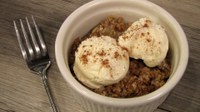Prairie Fare: Does an Apple a Day Really Keep the Doctor Away?
(Click an image below to view a high-resolution image that can be downloaded)
By Julie Garden-Robinson, Food and Nutrition Specialist
NDSU Extension Service
As I looked up at our apple tree with its big red apples, I was carried back in time to a memory of my children’s younger years. They usually help with the apple harvest if we have a good year. They have learned about a lot of things in the process.
“I want to pick apples, too!” my younger daughter announced as her older brother and sister headed into our backyard with plastic bags. She was about 4 at the time.
“She drops them on the ground and picks up the bad ones!” my then-12-year-old son said as he grabbed the apple picker from her little hands.
My then-9-year-old daughter nodded and said to her sister, “Yes, you need to stay inside!”
A battle of the siblings was brewing and it was going to be loud. I grabbed my little girl’s hand and sidestepped the eruption about to take place.
Keep in mind, I am the food and nutrition specialist and not the parenting expert. I did the best I could.
“OK, you will help me. I’ll pick the apples and give them to you. You will gently put them in the bag. Can you do that?” I asked my young daughter.
“Yes, I can!” she said, looking at her siblings through narrowed eyes. They grinned at their defiant little sister. She was a good apple-picking assistant. Even better, they all enjoyed apple slices for a snack that day.
Fortunately, as time has passed, my kids have become more patient with each other - most of the time, anyway. They still enjoy apples, especially when we make delicious recipes using them.
I have a special favor to ask of all of you readers of my column. Along with my colleague Esther McGinnis, NDSU Extension horticulturist, I invite you to complete a short Web-based survey about apples to learn your preferences. Participating will take about five minutes, and you can sign up for a chance to win one of 25 2016 calendars with recipes, and nutrition and food safety tips. If you win, the calendar will be mailed to you. Please go to http://tinyurl.com/NDSUapplesurvey to participate. (Thanks, by the way!)
Are apples healthful? A medium apple, which is about the size of a tennis ball, contains about 80 calories, 3 grams of dietary fiber and only a trace of fat. Apples are made up of about 85 percent water. The type of fiber apples contain, called pectin, has been linked with lowering blood cholesterol and potentially reducing the risk of heart disease.
Apples may help with weight maintenance or loss. For example, a 12-week study conducted in Brazil showed that overweight women ages 30 to 50 lost weight when they supplemented their diets with apples or pears. Groups of study participants ate either extra fruit or a cookie with fruit fiber. The group who ate an oat cookie with fruit fiber did not lose a significant amount of weight. In addition, the blood sugar levels among the group eating apples or pears decreased, compared with those eating the oat cookies with fruit fiber.
A more recent study examined the effects of apple juice on brain function. The researchers studied 21 nursing home residents ranging in age from 72 to 93. All were experiencing moderate to severe Alzheimer’s disease. The residents continued their regular diet with the addition of two 4-ounce glasses of apple juice daily. Although their ratings on the Dementia Rating Scale did not improve, their anxiety and agitation levels decreased.
Although the results of these two studies were promising, more research is needed. However, we do not need to wait for the results to enjoy more apples every day. Apples are a delicious and healthful ingredient.
When selecting apples, choose fruit without bruises. Fruit without blemishes tends to last longer. Store apples in a cool place just above freezing, such as in a refrigerator with humidity to help prevent shriveling.
Remember to wash apples with plenty of water, but no soap, before eating. If you have an abundance of apples, remember, they can be frozen, canned, dried or made into jelly. Visit https://www.ag.ndsu.edu/food for information and recipes about all types of food preservation.
If you press apples to make apple juice or cider, be sure to heat the juice to at least 165 degrees to kill bacteria that could be present. Foodborne illness outbreaks have been associated with fresh, unpasteurized apple juice. Store heat-treated apple juice in the refrigerator.
Here is a tasty recipe that my students tried in our food lab at NDSU. Yes, having a plain apple has fewer calories and no fat, so remember, this is a treat.
We tried this recipe with Honeycrisp apples. The apples on my Haralson tree, a tart Granny Smith or many other varieties would provide a tasty result as well. Check out the apple information in the produce section of many grocery stores to learn the best ways to use them.
Microwave Apple Crisp for One
1 Tbsp. butter
2 Tbsp. brown sugar
2 Tbsp. quick-cooking oats
1 Tbsp. all-purpose flour
1/8 tsp. cinnamon
1 medium apple (about 3 inches in diameter), peeled and sliced
To make crumble topping, soften butter by placing in a glass measuring cup and microwaving on high for about 10 seconds. Add sugar, oats, flour and cinnamon and mix. Place apple slices in a small microwave-safe bowl. Sprinkle the crumble topping over the apples. Microwave for about 2 1/2 minutes or until the apples are tender. If you do not have a turntable in your microwave oven, turn the dish one time. Serve with whipped topping or ice cream if you wish.
Makes one serving with 330 calories, 12 grams (g) fat, 57 g carbohydrate, 2 g protein, 3 g fiber and 110 milligrams sodium.
(Julie Garden-Robinson, Ph.D., R.D., L.R.D., is a North Dakota State University Extension Service food and nutrition specialist and professor in the Department of Health, Nutrition and Exercise Sciences.)
NDSU Agriculture Communication - Oct. 8, 2015
| Source: | Julie Garden-Robinson, (701) 231-7187, julie.garden-robinson@ndsu.edu |
|---|---|
| Editor: | Ellen Crawford, (701) 231-5391, ellen.crawford@ndsu.edu |



